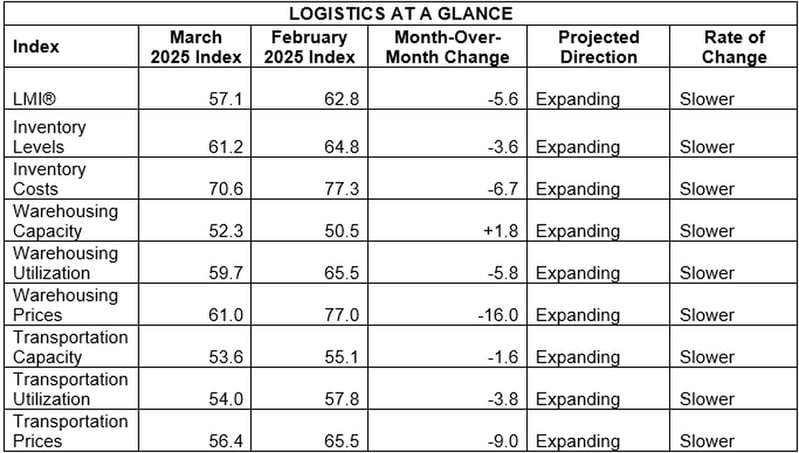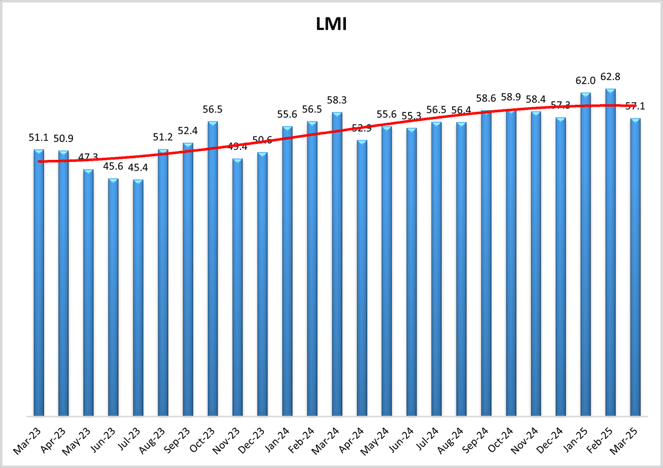Is the recovery trend over already for the freight market? The March Logistics Managers' Index (LMI) fell 5.6 from the prior month to 57.1. While it's still firmly in the growth category, the figure marks its lowest number since August of last year - dipping out of the 60s readings (which were near two-year highs) of January and February - and its third largest drop in history.
The monthly drop did not discriminate among LMI cost metrics, as Warehousing Prices fell the most (a whopping 16 points) to 61, Transportation Prices dropped significantly (-9 to 56.4), and Inventory Costs dipped 6.7 to 70.6. Authors say these downward changes suggest trade controls are taking an early toll after the start of the year saw supply chains focused on bringing goods in ahead of tariff issues.
Is it all bad news? With inventory and warehousing pricing metrics perhaps a bit elevated in February - maybe not for those. But the big decline in Transportation Prices is a potential red flag for the market.
Transportation Prices actually fell over the course of the month, from 60.5 in early March to 51.1 (almost no expansion) by the end. Add that with Transportation Capacity, which rose by late March to 54.9, and you have an inversion that has in the past signaled a downturn in the market, though it's an inversion that must last rather than be a couple-week reading.
In fact, the actual full-March figures had Capacity dipping 1.6 to 53.6, meaning Prices were still ahead by 2.8. Still, even in February, Transportation Prices outpaced Capacity by 10.4 points, and the gap - a sign of market health - was even higher in previous months. Transportation Utilization, incidentally, dropped 3.8 points to 54.
Taking a closer look at other metrics, Warehousing Utilization was down 5.8 to 59.7, Warehousing Capacity increased 1.8 to 52.3 (the only one to rise month-to-month). And Inventory Levels fell 3.6 to 61.2. All metrics are still in expansion, but it feels more tenuous as authors note warning signs in consumer sentiment, continued tariff concerns and re-emerging inflation worries that could keep interest rates up.
So are logistics pros surveyed still optimistic about the state of the market in 12 months? Much less so, as the future index dipped 5.6 points from last month to 60.6. Those surveyed showed concern about Inventory Level growth, only slotting that in at a moderate 55.7 (-13.4 from their February projection). And the pricing metrics a year from now between Inventory, Warehousing and Transportation came in at 34.1 points below what expectations were just last month.
By the Numbers
See the summary of the March 2025 Logistics Managers' Index, by the numbers:


About the Logistics Managers' Index (LMI)
Researchers at Arizona State University, Colorado State University, Rochester Institute of Technology, Rutgers University, and the University of Nevada, Reno - in conjunction with the Council of Supply Chain Management Professionals (CSCMP) - issue the report. The LMI score is a combination of eight unique components that make up the logistics industry, including: inventory levels and costs, warehousing capacity, utilization, and prices, and transportation capacity, utilization, and prices. The LMI is calculated using a diffusion index, in which any reading above 50.0 indicates that logistics is expanding; a reading below 50.0 is indicative of a shrinking logistics industry. The latest results of the LMI summarize the responses of supply chain professionals collected in March 2025.
Need assistance with your shipping operations? Request a quote with us, and we'll get back to you to discuss your unique needs. Go to our Freight Guides to learn more about everything freight and logistics. Additionally, visit our blog for information and updates on the freight industry.



